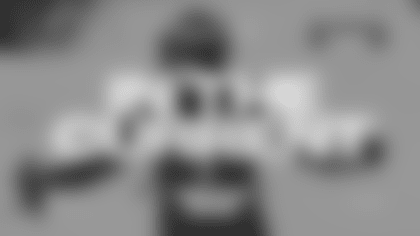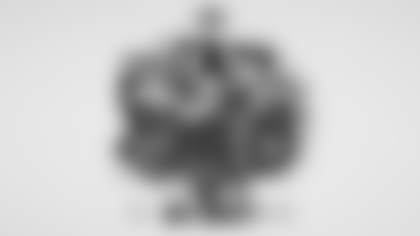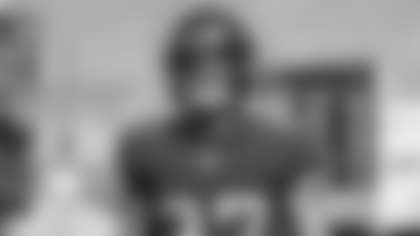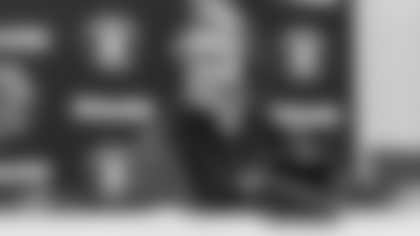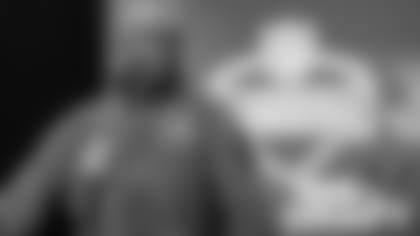RB Clifton Smith is the only player in Buccaneer history with touchdowns on both a kickoff return and a punt return
(Editor's Note: The following article was first published in Volume 3, Issue 10 of *Buccaneers Review, the Tampa Bay Buccaneers' groundbreaking answer to the traditional game program. Part 2 of the article is below; Part 1 was be posted on Monday.)
Returning punts in the National Football League – it's not a job for just anyone. Beyond the necessary skills of the eyes, hands and feet, a certain lack of the self-preservation instinct is almost essential. At some point it becomes second nature for the practiced return man, but how would the layman find the experience of staring up at a dot in the sky while 11 hardened men with bad intentions came streaking at him, knowing that in a moment he would be hurtling himself, against all common sense, toward those 11 men? Pro Bowl return man Clifton Smith takes us inside his head through the entire experience of returning a punt in the NFL, from the moment the ball takes flight to, in the best of cases, his feet take him into the opposing end zone. Smith also shares insight on the work that takes place even before game day to make a punt return successful.*
In Part 1 of this account, Smith shared some detailed insight on all of the preparation, during the week and during the game, that comes before an actual return. Below, he finishes the story, beginning at the moment the punt is kicked:
When I'm standing back there waiting for the punt, there's just one thing going through my head – don't be afraid. You can either be smart, or be real stupid. You can carry the hopes and the dreams of the whole team by either making a play or dropping the ball. There's a lot that runs through your mind, but I think the last thing that pops in your mind right as the ball is being kicked is, "Catch the ball first before you run."
As soon as the ball is kicked, I look at the two flyers that are on the outside, seeing what kind of releases they get on both sides. As soon as I see that, I look back up in the air for the ball, judge the rotation of the ball, and then you just kind of use your peripheral vision, what you can see out the corner of your eyes, to keep an eye on those guys. If you see any kind of movement in front of you, any kind of shadow, just be smart and call a fair catch.
Deciding whether to fair-catch a punt or to return, that's a big thing. You've got to determine how long the ball is in the air, and also the distance of it. If it's a high ball and it's short, your guys can't really hold their blocks like that. There's also a possibility of the other team pushing your guy into you, so just be smart and fair-catch the ball. I think the 'clock in your head' they talk about with quarterbacks dropping back to pass might be the perfect way to describe it. Just like a quarterback, you've got a clock in your head. Knowing how high the ball is in the air, you can determine if it's a hang time of four seconds or not, and the distance of it definitely plays a big role, because the punter might have great hang time, but he might outkick his coverage. There's a lot that goes into it.
As soon as the ball goes into the air, other things come into play when you're trying to catch the ball. The worst condition I've probably been in was being inside of a dome. Especially in Detroit, they have the big jumbo screen right behind both goal posts, so as soon as the ball goes in the air it kind of gets caught in the Jumbotron. At the same time the ball is in the air, the Jumbotron kind of changes colors, changes to different slides, so the backdrop is changing on you and you've really got to focus in. As soon as the ball gets above it, you can focus in to see how far it's going. You kind of get a late jump on it, but then again, you've still got that internal clock telling you if you need to fair-catch it or not.
Catching the ball is the number-one priority. You definitely have to focus on that. You can't run without the ball. You can't do anything without the ball. I've always been taught to look the ball all the way in. Then as soon as you look it all the way in, look up and see what's in front of you.
Sometimes you see those big hits where a punt returner gets lit up, but actually, I'm not worried about that at all. I've got great confidence in the guys in front of me. I know they won't let happen to me. I don't think about that one bit.
After I catch it, as soon as I look back up, I think about what the call was. I remember what the call was, then look at the different body positions that I have to kind of sort through. I really don't even look at the bodies – I look at holes. If you look at bodies, that's where you get in trouble because you start to think, "I don't know how I'm going to make this person miss. I don't know how I'm going to make that person miss." That's where you mess up. You've just got to find a hole, hit it and then just use your peripheral vision once again to see what other bodies are doing around you.
I actually look right through people. I just have the confidence to know that the first guy, he's not going to tackle me. So I look right through him and look to see what's going on around me.
The guys in front of you just make your job so much easier also, especially the guys that I have on that unit. They make my job easy, so all I've got to do is just catch the ball, make one person miss and I'm up the field already.
You can tell pretty quickly whether or not there's a chance for a big play. I think it's one of those things where if the flyers stay away from you, if the corners can block the flyers for a long period of time and I get past that first person, I know what holes to hit because my teammates do a great job getting in great body position and telling me by their body position which way to go. I just need a small crease, and as soon as I see that small crease, I hit it as fast as I can and just know that I might have to break a couple arm tackles. Once you break those arm tackles, you just look right at the punter – look right at him into his eyes and you know you've got him.
Once I break into the open, I actually start to laugh a little bit, and say, 'Oh yeah, I got it.' I make eye contact with the punter, and as soon as I get his eyes looking at me, he knows. He knows he's in trouble because he's kind of running backwards at the same time.
Definitely, the first guy isn't bringing me down, and neither is the last guy. It's about everyone in between.
I had some problems with fumbling for a while there, but the biggest thing is you've just got to be smart. You've got to know when to fight, and when to go down. That's kind of where I've been having my problems, because I don't know when to lay down. I've just never been that type of person where after the first hit, I'm just going to lay down. I'm going to try to go through everything I can. So you've just got to be smart about when to fight for extra yards and when to just call it quits.
You know going in that you aren't going to be able to return every one for a touchdown or even get a big return on every punt. But my teammates always, even if it's not a big play, they do a good job of coming up to me and just telling me, "Good job. As long as you catch the ball and hold on to it, we'll take care of the rest." Even in games that I fumbled, our defense came up to me and said, "Don't worry about it. We'll take care of it." And they have. The defense, every time I've fumbled, has gone out there and shut the offense down for no points. That's a great confidence-builder.
But I know that I'm getting the job done if I save the offense a first down. Ten yards or more, that's when I know I'm getting the job done. That's my goal, at the very minimum.
Returning punts is, I think, about 75 percent about the practice and the preparation. You stay after practice so much and catch balls from a live punter, just so you can judge the different rotation of the ball coming from different punters. Then you get on the JUGS machine and get the JUGS to shoot you different punts. Even though it's a lot easier on the JUGS machine, that's still giving you a sense of where the ball is going and how to judge it. The rest of the 25 percent is all instinct and athletic ability and going off what you know.
I think returning punts is one of those things – you either have it or you don't. That's something that's just so hard to teach somebody how to do. It's one of those things that if you can do it, you've got it. It's a great gift to have."







